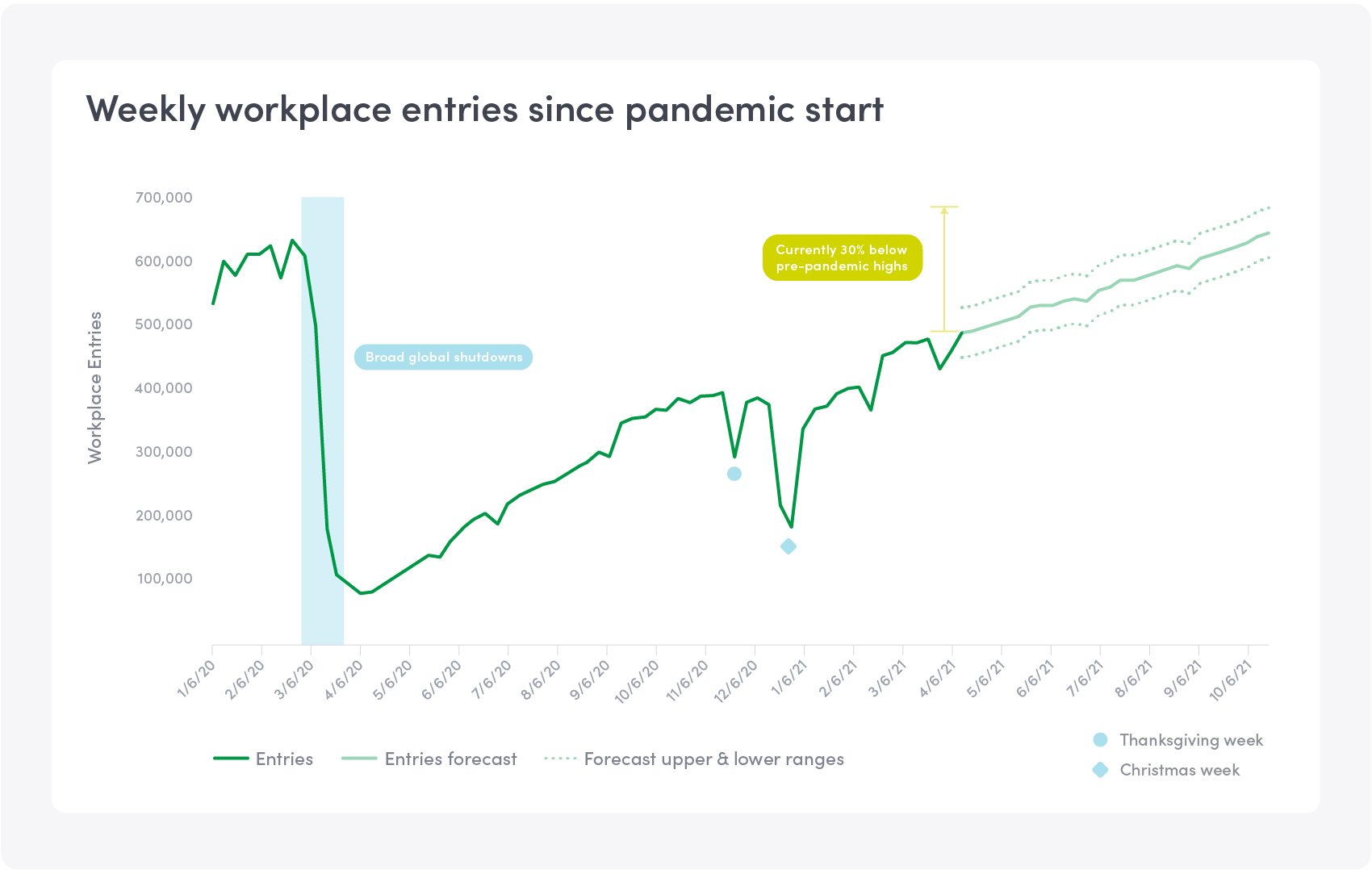After more than a year of gathering restrictions, companies around the world are beginning to reopen their workplaces. Employers are navigating uncharted waters and face many uncertainties around how to reopen. Will they have the resources they need to support employees when they return? How many people will come back? How will they manage capacity if there’s a surge in employees who want to return at once?In a new study, we analyzed over 20 million workplace entries over the past year. We wanted to understand return-to-work trends, which industries have the most employees going into the workplace, and how close organizations are to reaching their workplace capacities. Here’s some of what we learned:
- Global weekly workplace entries are up over 500% from their lows in April 2020
- The majority of companies haven’t reached state or country workspace capacity limits
- By October 2021, we project that the number of people going into the workplace on a weekly basis will return to the pre-pandemic normal
We’ll explain each of these points in detail below starting with trends in workplace capacity. Let’s dive into the data.
Workplace occupancy continues to increase
The pandemic will have a lasting impact on what work looks like going forward. In a recent survey, we found that most employees want to return to the workplace to keep work moving and collaborate with others. To understand just how many people have returned on-site, we looked at how many times employees and visitors signed into the workplace since January 2020. The data confirms that weekly workplace entries have gone up with relative consistency since the start of 2020. Month-over-month, entries have increased on average by 14% since lows in March 2020. In fact, entries are currently only 30% below pre-pandemic highs.

But how will things look moving forward? Based on current trends, our forecast indicates that by October 2021 the number of people going into the workplace on a weekly basis will return to the pre-pandemic normal. Since the start of 2021, weekly employee entries are up 68%. We also found that employees aren’t the only ones returning on-site. As restrictions lift and economies reopen, even non-employees have begun to visit workplaces again. Our data shows that visitor entries are up by 43% since the start of 2021.
Still, workplaces aren’t coming close to reaching capacity limits
To keep people safe and meet compliance standards, many companies are setting capacity limits for the number of employees and visitors allowed on-site at a given time. One question we’ve heard many companies raise is whether there’ll be enough space in the workplace to accommodate a surge in workplace entries. We found that not only is there space, 87% of companies have not had a single instance of going over capacity.What does this mean for employers? In short, most still have ample space available to welcome people back to the workplace. The average capacity ratio across all companies is 9%. In other words, most companies have a significant buffer to welcome many more employees and visitors into the workplace. For workplace leaders concerned about the coming rush of employees returning this summer, this is welcome news. Here’s what workplace capacities look like across different industries.

Unsurprisingly, companies that employ essential workers have consistently seen the highest capacity ratios. Generally speaking, the food and beverage, consumer staples, and retailing industries have remained open since the start of the pandemic. These industries typically have less available space relative to capacity, which could explain how high they appear on the chart. The pharmaceutical and biotech industries see more entries relative to capacity limits. These industries have most likely had employees working on-site since the start of the pandemic to develop vaccines and other essential medical resources.
Final thoughts
The return to the workplace is happening. Weekly employee entries are up 68% since the start of 2021 and visitor entries are up by 43%. We predict that workplace entries will be back to normal by October 2021. The data is clear: 87% of companies haven’t had a single instance of going over capacity and the vast majority have a lot of buffer room. Right now anyway, employers should worry less about going over capacity and focus on creating a workplace that encourages even more of their people to return.
Want to dive even deeper? We surveyed 1,000 employees on returning to the workplace. Check out what we learned in our ebook, Employees have a vision for the future of work and it’s hybrid.
Read more
Searching for a visitor management solution? Learn what to look out for and how to choose the best tech for your team.
Managing your space well doesn’t have to be difficult. But if you want to be successful, you need the right approach.
A well-run workplace can set your team up for success. Learn why workplace management matters and how to do it right.
Workplace security is critical to the future of your business. Learn why it matters, what threats to watch for, and how to strengthen your workplace security plan.
In this post, we’ll explore what workplace compliance is and how to build a compliance culture for your organization.
With more folks sending personal packages to the workplace, having a sound mailroom management system in place is key.









